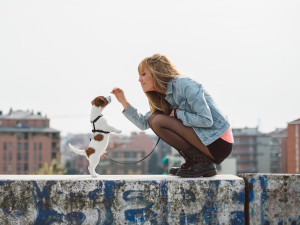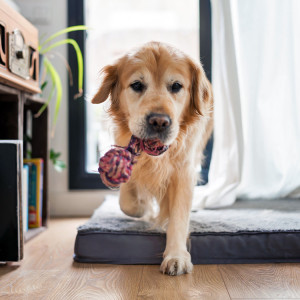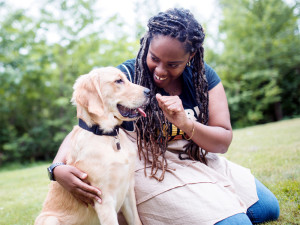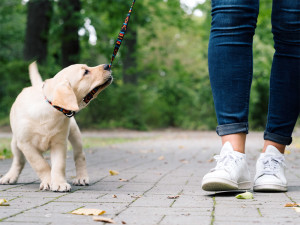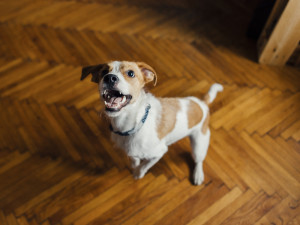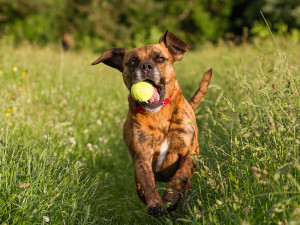How to Integrate Training Into Your Puppy’s Daily Life
Here are some tips for fitting training into your action-packed schedule
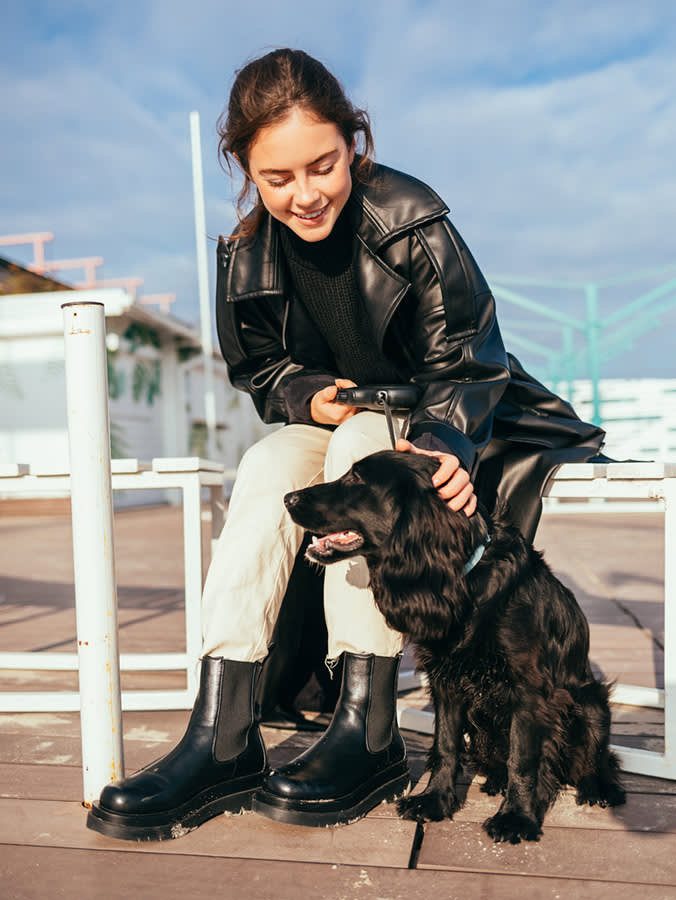
Share Article
There’s so much to teach puppies. Go to the toilet here, not there. Come when called, every time – and do it happily, please. Sit when you greet people. Go to your crate. Play with your toys, but leave shoes and stuffed animals alone. Walk next to me, and keep the lead loose. Stay, even if exciting stuff is happening. Hang out in your spot while the rest of the family eats dinner. How to play tug and fetch. Tricks such as high-fives, crawl, roll over and sit pretty – the list of what to teach our puppies goes on and on.
If you are feeling overwhelmed about training a new puppy, welcome to the club. There are so many skills and cues they need to learn, nobody can blame you. But rather than panic – often the first instinct – make the task manageable by integrating training into daily life.
Always have treats
School is always in session, so be prepared to teach the right lessons. Have treats at the ready – always on you in a treat bag, in the pocket of the jacket you wear on walks, stashed around the house in containers puppy can’t reach. Professional dog trainers love to catch their dog doing something right. If their dog sits when a visitor arrives or lifts their paw in a cute way, they’ll give the dog a treat so such behaviours will be more likely to happen again. There are endless opportunities to train throughout the day when you have treats on hand.
Every door offers a chance to practice wait
Dogs, like people, are regularly going in and out of doors, and that presents opportunities to teach your dog to wait and to practice this important safety skill. Whenever your puppy is not in a big hurry to go through a door to go for a wee – going in and out of the house, the crate and once they are big enough to do this without a lift, even the car – you can use the opportunity to train your dog to wait and to practice this skill.
Recalls, recalls, recalls
Reliably coming when called is one of the most important behaviours to teach any puppy. A good recall keeps dogs safe from possible danger, and a dog with a good recall can have more freedom – walking off the lead, playing in fields, joining you for picnics etc. The best way to teach a dog to come is to teach them that this cue predicts something wonderful.
Every time you have something your dog wants, call them to come so they become eager to respond to this cue. So many dogs respond every time to the sound of a lead (a walk is about to happen, yay!) and to the sound of a treat bag crinkling (I’m about to get a treat – yay!). Training a reliable recall is about harnessing those same good feelings and associating them with the cue to come. If you say ‘come’ before giving your puppy something they love, such as a toy or chew, or before going outside with them, or before giving them a belly rub, or playing a game of chase with them, your dog will want to respond to this cue by running right to you.
‘Sit’ is a good habit
Most dogs quickly learn that sitting is a good default behaviour when they want something; understanding with a bit of practice that if they sit, they get the same good results as if they said ‘please’. Teach them to sit as a habit before receiving their breakfast or dinner (and lunch, too), before you put on a lead and when you get to the edge of a curb on walks.
Reinforce every toilet success
You need to know if your dog has gone for a wee or poo, so they can come back in the house, have a rest in their crate or come in the car with you without creating a cleaning challenge. Just because they are outside does not mean they have gone to the toilet, so you must watch to know for sure. That means you need to be outside with them, supervising their activity and watching whether or not they go. Make good use of your time outside by giving them treats after every time. That’s how you let them know they’ve done the right thing by pooing or peeing in the garden or on a walk, and how you can make every bathroom event a training success.
Use their name to get their attention
Getting your dog’s attention is very important, so it’s useful to train your dog to look at you when you say their name. (You can train a dog to do anything if you have their attention, but without it, everything is whole lot harder.) Say your dog’s name, and if they look at you, give them a treat. If you have treats in your pocket, you can do this any time you and your puppy are together, making it easy to integrate into your day.
‘Four on the floor’ during greetings
Whenever you come home, offer them a treat and some attention for keeping all four paws on the floor. Far too many dogs jump up and become unpopular with guests because they leave paw prints, tear clothes and can hurt or frighten someone. They will seem more unruly than sweet no matter how friendly they are. Make it easier on your dog and yourself by teaching them from the beginning that every time they greet you, they will get treats and attention if all four paws are on the floor. If you prefer for your dog to sit in this context, then reinforce them for sitting during greetings.
Make hanging out fun
Teach them to go to their bed, on to a mat or in their crate when you are eating dinner, need to get some work done or are otherwise going to be occupied and unable to attend to them. Make it a positive experience for them by giving them something fun to do. If they receive a stuffed Kong or a puppy-safe chew toy, they will be happy and busy. The training lesson that it’s fun to be in that spot even if their person is doing something else is a valuable one for puppies to learn.
Check-ins on walks
Train your puppy to check in with you on walks by using treats to reinforce the behaviour of coming over to you. Puppies are often distracted on walks by all the sights, sounds and smells of the great outdoors, and they will become more distracted as they approach and enter adolescence. If you can teach your puppy that it’s worth it to come over to you even during the fun of a walk, you are helping them create a lifelong habit. Receiving treats on walks, as a reward for checking in, teaches dogs to pay attention to you.
Play offers more than just fun
Hopefully, one of the top reasons you love having a puppy is because of the playtime you get to have together. (It’s not the new sleep schedule, that’s for sure). Playing with toys is fun, as well as a great way to teach your dog useful skills. Teaching your dog to take something and to drop it on cue is a natural fit for the game of tug. When you play, tell your dog to take it and offer the toy, perhaps waving it around a bit or dragging it along the floor. When they do take hold of it in their mouth, reinforce that behaviour by playing tug with them.
After a brief session, tell them to ‘drop it’, put a treat by their nose, and when they let go, give them the treat, and then start a new game of tug after telling them to take it. You can repeat this multiple times so they get to play when they take it, and they get a treat when they drop it, but ‘drop it’ doesn’t always mean the end of the play session.
Fetch can also help dogs learn to drop it, especially if you play with multiple balls. You can train a ‘drop it’ skill by showing them a second ball while they are holding one; this makes many dogs drop the one in their mouths in anticipation of another ball being thrown. Make sure to throw your ball as soon as they drop the one in their mouth so they are promptly reinforced for dropping it. Dogs who get plenty of playtime are less likely to seek and destroy other objects in the house.
Heeling here, there and everywhere
Incorporating a heeling practice into your day means reinforcing your dog for walking next to you when you are walking anyway. That means you can do it when you walk around the house, whether you are headed to the bathroom, to the other room to grab a book or to the kitchen for a snack. Just a few seconds of walking by your side and receiving treats done a few times a day is enough to get a great head start on heeling. I also recommend doing this on walks for 10–15 seconds at a time a couple of times during each walk, offering treats generously for being in the right place by your side.
A few structured training sessions
There are some skills that are not so easily integrated into daily life, so the trick is figuring out a way to integrate some structured training sessions into your day. These sessions are essential for training skills that don’t come up as naturally. Training your dog to leave it so they don’t eat something gross, dangerous or valuable off the floor is easier to do in a planned way in the early stages.
Teaching your dog to touch a target or to do tricks – such as shake or roll over – or to stay are all best taught in sessions dedicated to training. Find a way to put small training sessions into your day: this can be during TV breaks, when you are waiting for the kettle to boil, your leftovers to reheat or your toast to pop up, or even when your housemate or partner gets in the shower first and you are waiting for your turn. Whenever your daily life leaves you with a brief pause, that’s a time you can train your dog. So, keep those little pauses in mind, and do your best to take advantage of them.
Integrating lots of the training into daily life makes it easier to manage and not so overwhelming. Integrated training also follows the principle that the best training for dogs – especially puppies – is done in really short sessions. Most people think of five minutes as short, but when dog trainers refer to short sessions, they often mean 30 seconds or even less. Finally, dog training is more fun and feels less like work when it’s just a part of your day rather than a big task waiting to be done. And with puppies, fun is what it’s all about.

Karen B. London, PhD, CAAB, CPDT-KA
Karen B. London, Ph.D., is a Certified Applied Animal Behaviorist and Certified Professional Dog Trainer who specializes in working with dogs with serious behavioral issues, including aggression, and has also trained other animals including cats, birds, snakes, and insects.
Related articles
![]()
How to Work Out What ‘Drives’ Your Dog
You might already have a good idea of what your dog likes, but it‘s not always that straightforward
![Dog barking]()
How to Stop Your Dog From Barking
The top five reasons dogs bark – and how to help them to relax
![person playing tug with dog]()
Three Myths About Playing With Your Dog
Chase? Wrestle? Tug-o-war? Find out which are fair game
![Dog playing fetch with tennis ball in long grass]()
How to Teach a Dog to Fetch
For some dogs, it’s not as simple as just throwing a ball

